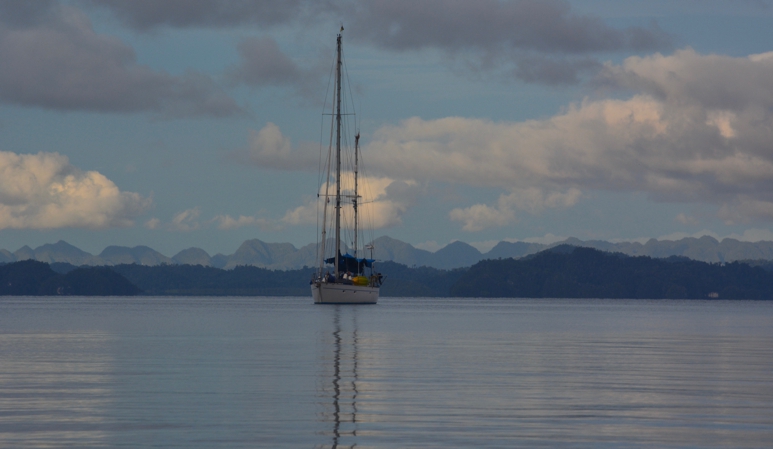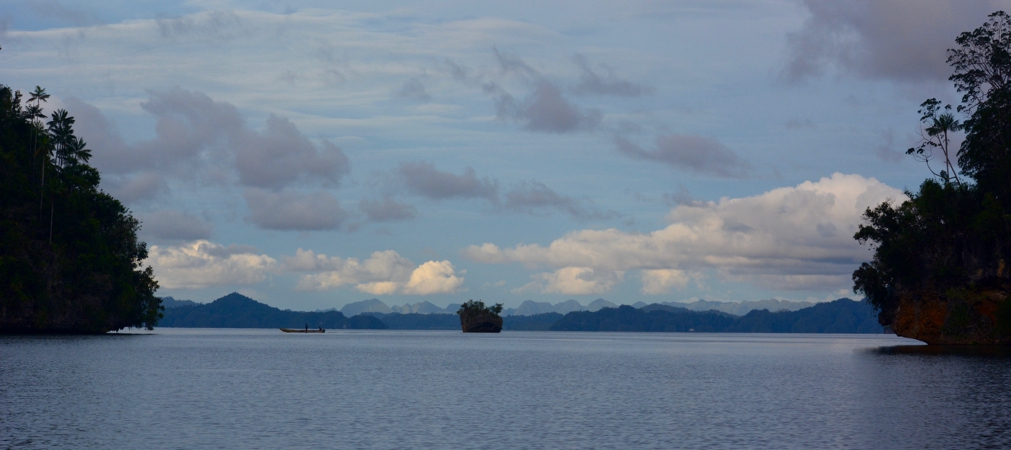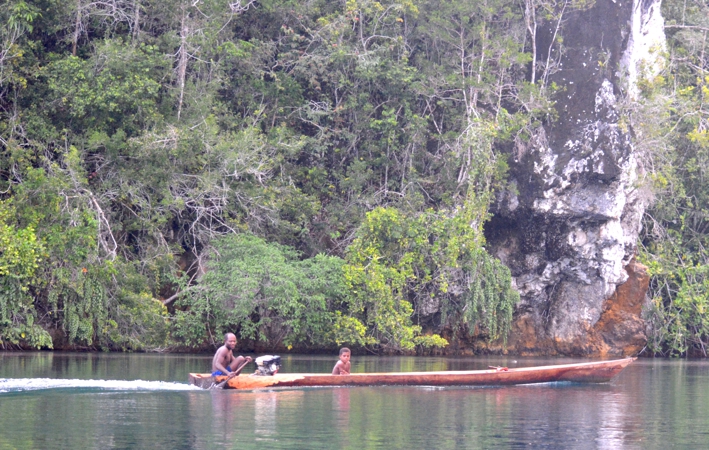Kabui Bay, Raja Ampat

Lochmarin
Sat 29 Oct 2016 06:50
00:24.587S 130:34.201E  Lochmarin in Kabui Bay. Our companions in the anchorage turned out to be running a sort of collective charter boat business, with young folk flying in for diving holidays, and weren’t the cruisers we’d hoped to be able to spend time with. We decided to move on.  Looking East in Kabui Bay. Looking for some protection from the swell we motored up into Kabui Bay. It was beautiful. A huge harbour, surrounded by beehive shaped limestone karst hills and ringed with little mushroom islets. We inched our way in to the shallows gingerly, looking for a reasonable depth to anchor in. Our depth sounder was playing up and the cloudy sky made it hard to spot the remains of Islets that had eroded down below the waterline. Finding a spot we dropped the anchor, turned off the engine and listened. The air was full of the sound of birds, relieved that the rain had stopped. Fluttering flutes, squawks and chirps, trills and beeps, whoops and whistles, soft coos and strident screeches all interspersed with deep guttural ‘rows'. Yes we know you’re making a row but where are you, and who are you?   A couple of our elusive serenaders Over the four or five days that we stayed there we searched endlessly for the birds. Quietly setting out in the first light of morning on our kayak, armed with cameras, we’d stalk them but they were shy. We’d hear a great commotion just around the corner and so we’d creep carefully round, staying in close to the underhang in order not to alarm them. There’d be a rush of wings, if we were lucky we’d see a flash of colour, and they’d be gone. We grew to recognise the steam train chuff of hornbills flying off as soon as we appeared, and the raucous crows complaining as they flew. The parrots flashed their colours high above us, their high pitched squawks accompanying their wing beats. Just occasionally one would be relaxed enough to let us photograph it, but only from far off using a long lens. It was frustrating and absorbing and a wonderful reason to spend time kayaking around the islets, finding passages under the mangroves into hidden lagoons where scores of butterflies danced in the sunlight.  Hornbills noisily flapping overhead, two males and a female. In the middle of the day, when the birds were taking their siesta, we would snorkel the stunning coral gardens around the feet of the Islets. Raja Ampat certainly lived up to its reputation for outstanding diving and snorkelling: the range of corals and variety of fish is marvellous. We particularly enjoyed the spadefish (also called batfish) that stayed in the deeper water near to the reefs.  Long finned spade fish It was a beautifully protected anchorage, perhaps a little too protected. At night I’d lie on our bunk desperate for a little breeze, just a little breeze, to make the heat bearable and the longed for sleep to come. Giving up I’d come out and lie on the pilot house roof trying to cool down, hearing the magical snorting breath of the dugong coming up for air nearby.  One of the local extra long dugout canoes going through The Passage, with inboard engine and long tail propeller going out through the stern, steered with a paddle. In the South Western corner of the bay is a channel that separates Waigeo from Gam, known as The Passage. It’s only 50 feet or so across at its narrowest part, flowing between vertical cliffs and around jungle covered islets. The current races through it, forming whirls and swirls and smooth glassy patches. The turtles come up to breath in the slack water to the side, looking at you with their wise eyes. I was astounded to remember that our friends on Adina (Those Who Have Gone Before Us) had taken their boat down it, carefully judging slack tide, thrill seekers or what? We had a fun dinghy ride down and back and a lovely snorkel at the Eastern end and felt perfectly content with that.  Peek-a-boo! |